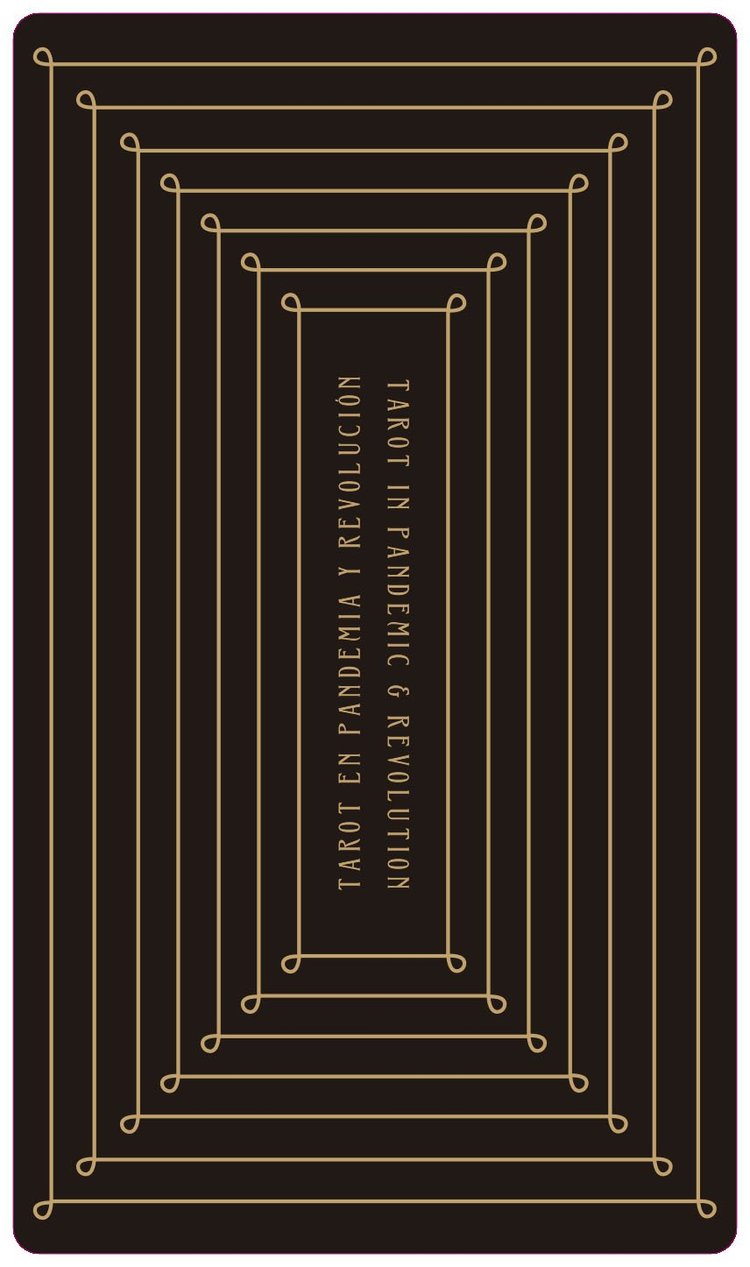

This astonishingly beautiful deck is the result of multiple collaborators inspired by the lucid dream of Peruvian-born artist, poet, performer, curator, activist, and cultural promoter Adrian Arias about a reading from a fortune teller using a Tarot deck with “beautiful and rare images.” (Arias, 2021, Introduction). In the introduction section of the booklet that comes with the cards, Arias tells us the cards in the dream held “images of viruses, masks covering mouths, Black Lives Matter posters, marches and protests, and more.” (Arias 2021, Introduction). The guidebook, which bears the title Guia Poetic: Poetic Guide, explicates each card’s meaning and imagery through poems written by different poets, followed by divinatory meanings. The entire work is “dedicated to those who have dropped their bodies yet still walk with us in altered form; the dreamers, the newborns, the emergent, the universal. To the path. May we embrace life, which always desires more life.” A total of 62 people contributed to the art and writing for this deck, and it is a magnificent communal effort.
I was initially concerned that I would have issues reading with a deck created by so many people, but as soon as I opened the box and sliced open the clear plastic wrapping, I was taken with the images. I pulled four cards for myself for a reading (which I won’t share specific details of here as I am still waiting for some things to emerge) and felt an immediate connection and resonance with the images. Although I know the deck is a supposedly inanimate object, I liked the deck and I felt that it liked me.
Before discussing the images and my experiences reading with the deck, here are a few hard and fast critiques. One drawback — and for me, I think the only drawback — to these cards is that they are printed on fairly thin card stock. This makes them very easy to shuffle but I do worry that they will be easy to damage. The box created for them is very sturdy, so I don’t fear that they will be easily damaged while in storage in the box, however I am concerned about reader clumsiness (and by reader clumsiness, I mean my clumsiness). They can be torn or bent if one is not being careful. All cards have their names in both Spanish and English on them, with the Spanish the bolder of the two. They all have black backgrounds with matte gold lettering and are printed on a matte surface. I found the design to be elegant and appealing.
I will share the cards I drew, as a reviewer can’t really give a review without sharing the images themselves. (See figure 1). In my own reading, I drew The World, The Wheel of Fortune, Queen of Swords, and Strength. (Yes, I was very pleased with this reading). Interestingly, the World and Strength cards are mirrors of one another as both contain a woman and a lion. I will share an example of the poetry that comes with each card. This poem was written by Mark Eisner to accompany the World card and, like all of the contributors, his biography appears at the end of the Guia Poetica.
We slip from our horses atop a slope facing West;
Below only desert till the Sierra outstretched.
We make fire watching dusk transcend over the hills; tones transform until the
world, bare, is draped by darkness.
The crackle of our fire against so much silence. As
We breathe it in, a cello note inside us from a brand
New crescent moon, rising from the south,
Aglow in orange loom.
Amber slivers the upright crescent, a torch held up
By the World’s hand through all that
Darkness, catching, collecting the reflections of all
Our fires, of our sun, its tenderness easing
The heat, softening rage.
After riding under so many moons, we now realize
That change will come.
We break camp in the morning and head to the
Valley below, emboldened by the glow, riding wherever we must go.
(Eisner, 2021, p. 70 – 71)
In addition to this beautiful poem, as with each card description, there is the general divinatory meaning given, as well as specific applications for each card’s meaning in different contexts, such as love, work, or finances. I found this incredibly useful, as did one of my Tarot students, who commented that she appreciates the specific insight on a card’s meaning for particular areas of one’s life.
In addition to reading for myself, I performed readings using this deck for several friends and included it as a deck I used in my daily Facebook Live Card of the Day reading. I found the images on the cards and the interpretations in the book to be accurate depictions of what I was picking up from my clients and the general milieu of a particular day. My friends and followers were delighted by the images as well as the poetry.
At $75.00, the deck may seem expensive, however it is a very unique deck and worth the price, due to the talents of everyone involved. I do think $75.00 may make the deck inaccessible for some, which is a shame because it includes so many multicultural and diverse images. It is after all, a deck of pandemic and revolution, intended to help give direction in these troubled times.
In conclusion, I really enjoyed the opportunity to take a deep dive into this deck to explore the imagery and words behind the images. It is definitely a deck I will use again for all kinds of readings. If you are looking for a truly inclusive deck that celebrates POC of diverse descent, as well as one that provides elegant and well-thought-out interpretations in the accompanying book, then you will love this deck.
Reference page:
Arias, A., Baldocchi, R., & et. Al., (2021). Tarot in Pandemic and Revolution. Oakland, CA: Nomadic Press.
 Helena Domenic is an accomplished artist, writer, witch, and professor of art history and studio art. Helena spent thirty years as a member of the Assembly of the Sacred Wheel and was also an Elder in that tradition. She left to carve out her own path, both as an artist and a witch. Currently, she leads the Chester County Pagan Meetup and the Brandywine Kindred, a newly formed coven in Chester County.
Helena Domenic is an accomplished artist, writer, witch, and professor of art history and studio art. Helena spent thirty years as a member of the Assembly of the Sacred Wheel and was also an Elder in that tradition. She left to carve out her own path, both as an artist and a witch. Currently, she leads the Chester County Pagan Meetup and the Brandywine Kindred, a newly formed coven in Chester County.
Helena has shown her artwork in Philadelphia, New York, across the United States and in Egypt and South Africa. Helena was born in Vicenza, Italy where she was exposed to great works of art from a very early age. After viewing the Sistine Chapel ceiling at the age of eighteen months, her mother predicted she would become an artist. She holds a BFA from Kutztown University, an MA in Art Education from The University of the Arts, and an MFA from Goddard College in Plainfield, Vermont. She currently teaches Studio Art at Kutztown University.
Helena has a forthcoming book called An Illuminated Guide to Wicca, available from Schiffer Publishing, coming out in April 2022. Helena has also created a Tarot deck and book, The Fellowship of the Fool Tarot, as well as a Runic Oracle deck and a Lenormand deck. Helena also writes articles on art, music, and tarot for Coreopsis, the Journal for the Society of Ritual Arts.
In her spare time, she enjoys studying Tarot and Qabala, and spending time in her studio in Phoenixville, PA.
Helena’s work may also be seen on her website: http://artofhelenadomenic.com
For more information, you may email Helena at helena@artofhelenadomenic.com